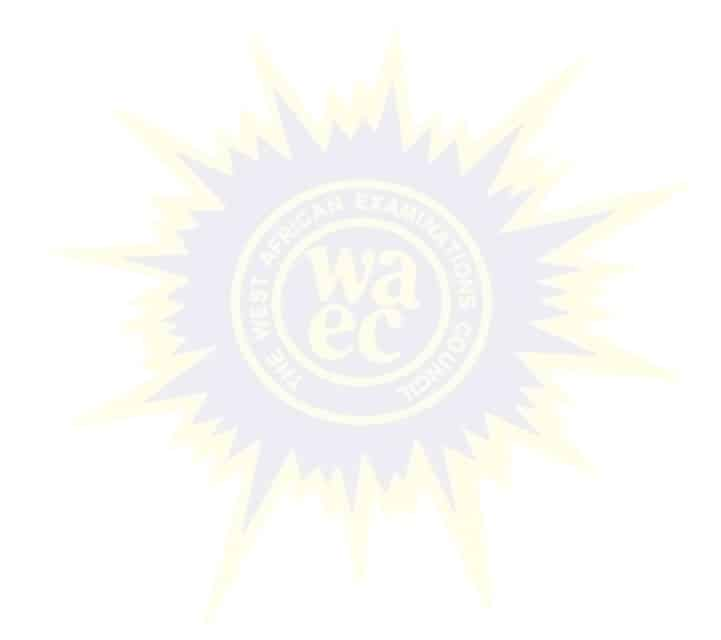
Biology
Paper 1 | Objectives | 60 Questions
WASSCE/WAEC MAY/JUNE
Year: 1995
Level: SHS
Time:
Type: Question Paper
Answers provided
FREE
No description provided
Feedbacks
This paper is yet to be rated

Paper 1 | Objectives | 60 Questions
WASSCE/WAEC MAY/JUNE
Year: 1995
Level: SHS
Time:
Type: Question Paper
Answers provided
No description provided
This paper is yet to be rated
Did you apply the MTN Ghana Bright Scholarships 2022 for Ghana Undergraduate Students?
Scholarship in Norway universities are open for application in 2022 also for developing countries.
Make sure you study hard but not into the late-night hours to give your body the enough rest you need.
| # | Question | Ans |
|---|---|---|
| 1. |
At what level of organisation is Amoeba? A. Tissue B. Organ C. Cellular D. System E. Filament |
C |
| 2. |
Which of these could be regarded as an advantage of complexity in higher organisms? A. there is no cellular differentiation B. Cellular differentiation leads to loss of independence of the cells C. Complexity stops at cellular differentiation only D. Cellular differentiation leads to internal structural specialization |
D |
| 3. |
Which of the following organisms is one-celled and free-living? A. Volvox B. Spirogyra C. Rhizopus D. Chlamydomonas E. Hydra |
D |
| 4. |
One of the differences between plant and animal cells is that in plants A. 'cells have less distinct outline, but animal cells have distinct outline B. ell wall is made of cellulose, but animal cell wall is made of chitin C. large vacuoles are absent, but present in animals D. plastids are absent, but present in animals E. carbohydrates are stored as starch, but as glycogen in animals. |
E |
| 5. |
Carbondioxide enters the stomata during photosynthesis through the process known as A. osmosis B. active transport C. diffusion D. inhalation E. ventilation |
C |
| 6. |
Which of the following groups carry out similar functions in living things? A. Vertebral column, chitin, and guard cells B. Sclerenchyma, cartilage and chitin C. Tendon, chitin and neurone D. Collenchyma, Intercellular spaces and blood vessels E. Blood vessels, lymph and shell |
B |
| 7. |
Which of the following statements is correct? A. biceps muscles has its origin on the head of the humerus B. biceps muscle is inserted at the ulna C. triceps muscle originated at the scapula and head of the humerus D. ulna is pulled up when the biceps is relaxed E. radius is the point of insertion of triceps muscle |
C |
| 8. |
Which of the following pairs of tissues is responsible for strengthening the plant? A. Phloem and Epidermis B. Parenchyma and Cambium C. Collenchyma and Sclerenchyma D. Collenchyma and Cambium E. Xylem and Cambium
Show Content
Detailed SolutionCollenchyma cells have thin primary walls with some areas of secondary thickening. Collenchyma provides extra mechanical and structural support, particularly in regions of new growth. Sclerenchyma cells have thick lignified secondary walls and often die when mature. Sclerenchyma provides the main structural support to a plant. |
|
| 9. |
Which of the following is not a tissue found in plants? A. Epidermis B. Phloem C. Xylem D. Dermis E. Mesophyll |
D |
| 10. |
Higher organisms use a transport system and not diffusion only to distribute nutrients because A. the ratio of their surface area to volume is small B. metabolic waste products diffuse to the surface of the organisms C. the rate at which nutrients and other substances diffuse increases D. substances to be transported move shorter distances to reach the numerous cells E. the internal structures of the organisms are in direct contact with the environment. |
A |
| 11. |
In complex food relationships in a community, the primary, secondary and tertiary consumers are referred A. symbionts B. omnivores C. heterotrophs D. autotrophs E. carnivores |
C |
| 12. |
The cell membrane of a cell is said to be semi-permeable because A. it allows only large molecular substances to pass through it into the cell B. it is actively involved in energy production in the cell C. it actively allows all substances to pass through it by diffusion D. it is actively selective in allowing substances pass through it E. fatty acids are only the building blocks of the membrane |
D |
Preview displays only 12 out of the 60 Questions